|
|
|
It's
A Christmas Knockout 1973
Festive Jeux Sans Frontières Special
Entrants
1973:
Belgium (B) • Great Britain (GB) • Italy (I) • Netherlands (NL)
Presenters:
Michel Lemaire (RTB - B)
Stuart Hall (BBC - GB)
Giulio Marchetti and Rosanna Vaudetti (RAI - I)
Barend Barendse and Dick Passchier (NCRV - NL)
International Referees:
Gennaro Olivieri
Guido Pancaldi
National Referees:
Marcel LeFavre (B)
Franco Crameri (CH)
Livio Orvani (I)
Ben Bril (NL)
Scoregirls:
Lydia
Franca
Production Credits:
National Producers:
Diane Lange (B),
Barney
Colehan (GB),
Dick van 't Sant (NL);
Games Designer: Adolfo 'Popi' Perani;
Producer:
Luciano Gigante;
Director:
Gian Maria Tabarelli (I)
Produced by
RAI (I)
in association with RTB-BRT (B), BBC Manchester (GB), NCRV (NL)
|
Key:
International Christmas Special
● =
Winner of Christmas Special
▲ = Promoted to Position / ▼ =
Demoted to Position |
|
|
I |
It's
A Christmas Knockout 1973 |
Christmas
Special |
|
Event Staged: Saturday 8th December 1973
Venue:
Stadio Olimpico del Ghiaccio (Olympic Ice Stadium), Cortina d’Ampezzo, Italy
European Transmissions (Local Timings):
RTB (B): Monday 24th December 1973, 8.25-9.15pm (La veille de noël)
RAI Uno (I): Tuesday 25th December 1973, 8.45-9.55pm (Il Natale)
BBC1 (GB): Wednesday 26th December 1973, 2.35-3.25pm (Boxing Day)
Nederland 2 (NL): Monday 31st December 1973, 7.10-8.00pm (Oudejaarsavond)
Weather Conditions: Light Snow |
|
Theme:
Festive Fun |
|
Teams:
Pepinster (B) v. Aviemore (GB) v.
Cortina d’Ampezzo (I) v. The Dutch Sports Stars (NL) |
|
Team Members included:
Aviemore (GB) - Hughie Clarke, Kenny Dixon, Jacqui Driver, Stewart
Forbes, Marilyn Hemingway, Mary MacKenzie, Arthur MacLean, Iain McDonald, Bill
McKenna, Lorna McKenna, Iain Malcolm, Jill Patterson, Malcolm Wilkie;
The Dutch Sports Stars (NL) - Ad van Ommen (Team Captain), Nico
Chiotakis, Ingrid Dusseldorf, Piet van Eijsden, Keetie Hage, Jan Janssen, Arie Klein,
Ada Kok, Paul Litjens, Rudi Lubbers, Egbert Nijstrad, Eddy Pieters Graafland,
Erica Terpstra, Charles Urbanus Jr., Ria Rietveld-van Velzen, Els
Veentjer-Spruit, Ineke van der Veldt, Eddy Verheyen. |
|
Games:
The Christmas Tree Star, Comet in the Sky, The Flying Doves, The Christmas
Presents, Bears and Stockings, Giant Mono-Skiing Snowmen, The Ostrich Eggs and
Caramels on the Tree. |
|
Game Results and Standings |
|
Games |
|
Team /
Colour |
1 |
2 |
3 |
4 |
5 |
6 |
7 |
8 |
|
Points Scored |
|
B |
1 |
1 |
2 |
4 |
1 |
2 |
1 |
2 |
|
GB |
2 |
3 |
3 |
1 |
4 |
1 |
1 |
1 |
|
I |
4 |
2 |
4 |
3 |
4 |
4 |
3 |
4 |
|
NL |
3 |
4 |
2 |
2 |
2 |
3 |
4 |
3 |
Running Totals
(Leading teams shown in red) |
|
B |
1 |
2 |
4 |
8 |
9 |
11 |
12 |
14 |
|
GB |
2 |
5 |
8 |
9 |
13 |
14 |
15 |
16 |
|
I |
4 |
6 |
10 |
13 |
17 |
21 |
24 |
28 |
|
NL |
3 |
7 |
9 |
11 |
13 |
16 |
20 |
23 |
|
|
|
Result |
Team |
Points |
Final Scoreboard |
|
1st
2nd
3rd
4th |
I •
Cortina d'Ampezzo ●
NL • The Dutch Sports Stars
GB • Aviemore
B • Pepinster |
28
23
16
14 |
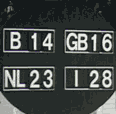 |
|
The Host
Town |
|
Cortina d'Ampezzo, Italy
Cortina d’Ampezzo is a town and winter sport resort with a permanent
population of around 6,200 inhabitants in the Veneto region of northern Italy.
It is located in an alpine valley in the heart of the Dolomites mountain
range, 124km (77 miles) north of Venezia, 257km (159 miles) north-east of
Milano and 120km (75 miles) east of Rateče and the Slovenian border. It is
referred to as the ‘Queen of the Dolomites’ and is known for its ski-ranges,
scenery, accommodation, shops, après-ski scene and its jet-set and European
aristocracy crowd.
Situated at the top of the Valle del Boite, Cortina d’Ampezzo is encircled
360° by the Dolomites. The town centre is located at an elevation of 1,224m
(4,015ft), although the highest point is that of the Tofana di Mezzo which
towers at 3,244m (10,643ft). There is a significant water presence in the
territory in the form of torrents, streams and little lakes, which fill
particularly during the summer snow-melt season. Fauna include marmots, roe
deer chamoises and hares.
During the Middle Ages, Ampezzo fell under the jurisdiction of the Holy Roman
Empire, but in 1420, the village was conquered by the Republic of Venice. In
1508, it was conquered by Austria and by 1511, the people of Ampezzo swore
loyalty to Emperor Maximilian I (1459-1519). Following Italy's victory in
World War I, Ampezzo was finally given to Italy and, although remaining a
Habsburg possession until 1920 and being home to an ethnic German minority,
Ampezzo never became a teutophonic (German-speaking) territory. Instead it
conserved its original language of Ladin, which is similar to the Swiss
Romansch language, but one that is only spoken in the Dolomitic area.
After the War, the town was renamed Cortina d'Ampezzo (Curtain of the Ampezzo
Valley), adopting the name of one of the six villages that made up the
territory of Ampezzo, located in the middle of the Ampezzo valley.
Already an elite destination for the first British tourists from the late 18th
century up to the early twentieth, Cortina d'Ampezzo also became a favourite
resort for upper-class Italians after World War I. On the announcement that
the town had been chosen to host the VIIth Winter Olympic Games of 1956, a new
airport was constructed, which today is no longer in use.
After playing host to the Games, it became a world-renowned resort,
experiencing increased mass tourism and as a result, the town and surroundings
have found themselves being utilised for various world cup events and motion
pictures. Much of 1963 classic The Pink Panther, the progenitor of the
film series starring Peter Sellers (1925-1980), was filmed in Cortina
d’Ampezzo. One of the most memorable James Bond stunt sequences in the 1981
film For Your Eyes Only, where Bond has to escape a crew of assassins
on spike-wheeled motorcycles was filmed there, with his route taking them all
onto the resort’s bobsleigh run. The scene of the first attack on Bond
(portrayed by British actor Roger Moore (1927-2017)) and his partner Melina Havelock
(portrayed by French actor Carole Bouquet), in which two motorcyclists
attempt to run them over only for Bond to eliminate them both, was set in the
actual town centre. Since it was not snowing in Cortina d'Ampezzo by the time
of filming, the producers had to pay for trucks to bring snow from nearby
mountains, which was then dumped in the city's streets! Also filmed on its slopes were several scenes in the 1993
film Cliffhanger starring Sylvester Stallone as well as some in the
1983 film Krull starring Ken Marshall and Lysette Anthony.
Following a 70-year hiatus, Cortina d’Ampezzo will again play host to the
Winter Olympics when it shares the honours with Milano in 2026.
|
|
The
Visiting Towns / Teams |
|
Pepinster is a town with a population of around 11,000 inhabitants in the
francophonic (French-speaking) province of Liège and is located 647km (402
miles) north-west of Cortina d’Ampezzo.
Aviemore is a town with a population of around 3,000 inhabitants in the
Scottish council area of Highland and is located 1,606km (998 miles)
north-west of Cortina d’Ampezzo.
The Dutch Sports Stars were a team from Netherlands comprised of famous
names associated with the world of sport.
|
|
The Venue |
|
Stadio Olimpico del Ghiaccio
(Olympic Ice Stadium)
The
games were played at the Olympic Ice Stadium which was constructed between
1952 and 1954, primarily as an open-air figure skating arena after the town
was awarded the honour of hosting the 1956 Winter Olympic Games.
The
venue was inaugurated on 26th October 1955 and was designed to hold between
7-8,000 spectators, with the possibility of making temporary arrangements to
accommodate 12-15,000 spectators for the period of the Olympics. During the
Games, the arena held the opening and closing ceremonies, the figure skating
events and selected ice hockey games. Although originally open-air, a roof was
added to the structure sometime after 1981.
Akin with the town, the stadium was also utilised in the 1981 film For Your
Eyes Only, where Bond met with the villainous Aris Kristatos (portrayed by
British actor Julian Glover) wherein Kristatos (the real villain) tries to
trick Bond into pursuing and killing his rival Milos Columbo (portrayed by
Israeli actor Chaim Topol (1935-2023)).
|
|
The Games
in Detail |
|
Game 1 - The Christmas Tree
Star
The
first game - ‘The Christmas Tree Star’ - was introduced by RAI co-presenter
Giulio Marchetti and played in unison over 3 minutes 30 seconds duration. It
featured a male competitor from each team dressed as a Santa Claus and a 10m
(32ft 9¾in) high Christmas tree. Adjacent to the tree was a small podium
resting on four legs each comprising two blocks. On the whistle, the
competitor had to stand on the podium and raise a large golden star up the
front of the tree by means of small metal rods (located in a container at the
base of the tree) which had to be added one-by-one under the star.
Contemporaneously, an opposing female team member crouched on a curling stone
and equipped with a ball and chain had to be pushed down the ice rink by a
male team-mate in order to knock the blocks from under the podium and hinder
the competitor’s progress. The stone was attached to an elasticated rope and
would return to the opposition area once at full stretch. If the competitor
was knocked off the podium, he would need to rebuild it before continuing to
play. The team completing the game in the faster time would be declared the
winners.
| |
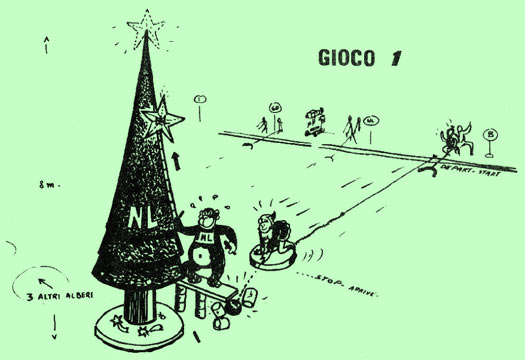 |
| Image ©
RAI, 1973 |
| |
This
was a very straightforward game which saw Italy and Netherlands in opposition
against each other and likewise with Belgium and Great Britain. It ended with
Italy completing the game in just 47 seconds followed by Netherlands in 2nd
place in 1 minute 20 seconds and Great Britain in 3rd place in 1 minute 21
seconds. Belgium, having failed to complete the game in the permitted time,
were deemed to have finished in 4th place.
|
Running Scores and Positions:
1st Cortina d'Ampezzo (I) (4pts awarded / 4pts
total)
2nd The Dutch Sports Stars (NL) (3pts / 3pts)
3rd Aviemore (GB) (2pts / 2pts)
4th Pepinster (B) (1pt / 1pt) |
|
Comments:
At the end of this game, referee Guido Pancaldi annotated
the times and points awarded to Belgium and Great Britain incorrectly on
the portable mini-scoreboard being held by the scoregirl. However, as he
read out the points awarded and they were added to the master scoreboard,
it was clear that he had realised his mistake, as he could be seen in the
background erasing the times and adjusting them to their correct
positions! |
Game 2 - Comet in the Sky
The
second game - ‘Comet in the Sky’ - was introduced by RTB commentator Michel
Lemaire and played individually over 1 minute 15 seconds duration. It featured
a large star hanging 10m (32ft 9¾in) above the arena and five female
competitors from each team, four of whom were equipped with a large net inside
which was a comet (in reality a large rubber ball with silver streamers
attached). On the whistle, the four competitors had to toss the ‘comet’ up
into the air and through the centre of the star for it to be caught cleaning
by the fifth competitor to end the game. If the comet was not caught or it
touched the ice, it had to be replaced in the net by the single competitor and
the game then repeated. The team completing the game in the faster time would
be declared the winners.
| |
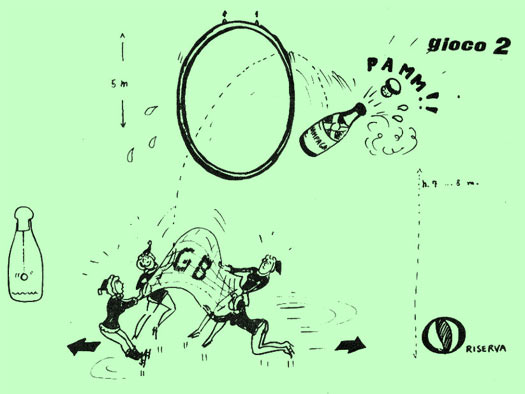 |
| Image ©
RAI, 1973 |
| |
The
first heat of this straightforward game saw the participation of Italy and
following five unsuccessful attempts, the comet passed through the star and
was caught by the female on the other side on their sixth. However, the
‘success’ was deemed null and void as she had permitted the comet to touch the
ice. Despite this setback, she replaced the ball into the net and they
achieved their goal with the very next attempt and completed the game in 58
seconds.
The
second heat featured Belgium and they were very inept in their execution of
the game. However, after ten failed attempts, they finally achieved their goal
with their eleventh and completed the game in limit time of exactly 1 minute
15 seconds.
The
third and penultimate heat saw the participation of Netherlands and they
showed the other teams how to play the game by tossing the comet through the
star with their first attempt and completed the game in just 5 seconds.
The
fourth and final heat featured Great Britain and, although they failed to
achieve their goal on the first attempt, they completed the game in 16 seconds
with their second.
|
Running Scores and Positions:
1st The Dutch Sports Stars (NL) (4pts awarded / 7pts total) ▲
2nd Cortina d'Ampezzo (I) (2pts / 6pts) ▼
3rd Aviemore (GB) (3pts / 5pts)
4th Pepinster (B) (1pt / 2pts) |
|
Comments:
The original idea for this game was for a large rubber
champagne bottle to be tossed through the star. However, during rehearsals
it was apparent that the shape of the bottle hindered the execution of the
game with no team being able to get it through the star’s centre. To avoid
stalemate during the actual recording, the bottle was replaced by a large
ball!
Whilst the ‘throwing’ four competitors wore flat footwear
and the fifth female wore ice skates in the other heats, the Netherlands
quintet all wore ice-skates and completed the game almost before it had
begun!
|
Game 3 - The Flying Doves
The
third game - ‘The Flying Doves’ - was introduced by NCRV commentator Dick
Passchier and played in unison over four minutes duration. It featured a male
competitor from each team dressed in a pantomime horse costume and equipped
with a large butterfly net. Around the arena were four national referees
sitting on raised tennis umpire seats with a small dovecotes attached. On the
whistle, one of the referees had to release a dove from the dovecote and
whilst it flew around the arena above the competitors’ heads, their task was
to catch it in their net. Any doves that were caught had to be placed on small
individual fir trees located at the edge of the rink. Any doves that flew out
of the arena or landed on the ice before being caught were nullified and a
replacement released. Competitors had to move quickly after catching a dove
because whilst taking their captured bird to their respective tree, a
replacement would be released immediately and without hesitation. The team
collecting the greater number of doves would be declared the winners.
| |
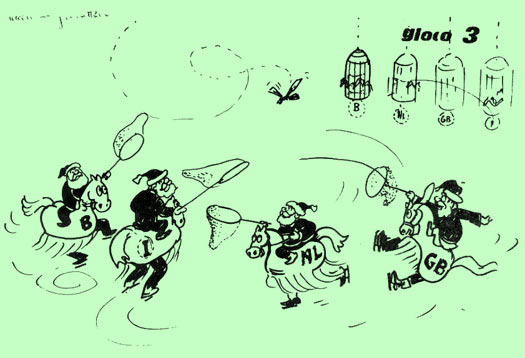 |
| Image ©
RAI, 1973 |
| |
Although this was a straightforward game it was fought very competitively. At
the end of permitted time, the results revealed that Italy had caught a total
5 doves, Great Britain had caught 4 doves and both Belgium and Netherlands had
caught 3 doves each.
|
Running Scores and Positions:
1st Cortina d'Ampezzo (I) (4pts awarded / 10pts total) ▲
2nd The Dutch Sports Stars (NL) (2pts / 9pts) ▼
3rd Aviemore (GB) (3pts / 8pts)
4th Pepinster (B) (2pts / 4pts) |
|
Comments:
This was an ingenious and magical game from the mind of
Italian games designer Adolfo ‘Popi’ Perani and featured specially
manufactured mechanical flying doves and would be remembered as one of the
most delightful games to watch in Jeux Sans Frontières history.
|
Game 4 - The Christmas
Presents
The
fourth game - ‘The Christmas Presents’ - was introduced by BBC commentator
Stuart Hall and played individually over 1 minute 10 seconds duration. It
featured eleven wrapped Christmas presents of varying sizes wrapped in silver,
red, blue and green coloured metallic paper at one end of the rink and a male
competitor from each team dressed as a Victorian chimney-sweep kneeling on a
curling stone attached to an elasticated rope at the other. On the whistle,
two male team-mates had to push the curling stone down the course to the
podium where the presents were located. If the pushers were accurate and the
competitor on the curling stone reached the podium, the competitor could
decide how many of the presents to transport with him back to the start.
However, he would not be permitted to stand up on the stone to reach them. The
game then had to be repeated throughout. Any boxes that fell down onto the ice
had to be retrieved by a female team-mate and placed back on the podium. Only
boxes returned to the start would be counted. At the base of the podium, there
were two small boxes wrapped in silver paper on top of which were four medium
boxes wrapped in red. Above these were three large boxes wrapped in green and
at the top of the pile were two extra-large boxes wrapped in blue paper. The
team collecting the greater number of boxes would be declared the winners.
The
first heat of this straightforward game saw the participation of Great Britain
who made a complete shambles of the game. On the first run, their competitor
knocked all the boxes off the podium, securing only two of them and taking
them back to the start after 15 seconds of elapsed time. On the second run, he
failed to reach the podium and collect any boxes at all. On his third run,
although he removed five boxes from the podium, four tumbled to the ground and
he returned to the start with just run after 58 seconds. With just twelve
seconds remaining, the team attempted a fourth run, and whilst they reached
the podium and removed three boxes, the competitor slipped from the curling
stone. The score was confirmed as 3 boxes.
| |
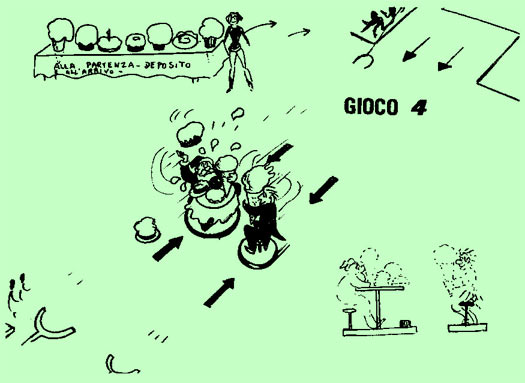 |
| Image ©
RAI, 1973 |
| |
The second heat featured Netherlands and on his first run, their competitor
failed to reach the podium and collect any boxes at all and returned to the
start after 17 seconds of elapsed time. On his second run, although he
attempted to collect the top seven boxes, he dropped most of them and ended up
with just one being brought back to the start after 44 seconds. However, his
third and final run was to prove more fruitful and he secured another four to
give them a total of 5 boxes in 1 minute 8 seconds.
The third and penultimate heat saw the participation of Belgium and, despite
their competitor being just 1.62m (5ft 4in) tall, he made the game look
simple after securing the top five boxes on his first run after 29 seconds of
elapsed time. His second run proved just as fruitful with another five boxes
and on his third run he brought back his final box. Their score was confirmed
as eleven boxes in 1 minute 9 seconds.
The fourth and final heat featured Italy and on his first run, their
competitor brought five boxes back to the start. However, just before crossing
the designated line, the two extra-large boxes tumbled from the pile after 22
seconds of elapsed time. Whilst his female team-mate skated up the ice to
retrieve them, he started his second run and secured all six of the
smaller-sized boxes and brought them back to the start after 51 seconds. With
the two extra-large boxes back on the podium, he made his third run and
although he lifted both of them off the podium, the backward pull of the rope
caused the top box to tumble. Their score was confirmed as 10 boxes in 1
minute 8 seconds.
|
Running Scores and Positions:
1st Cortina d'Ampezzo (I) (3pts awarded / 13pts total)
2nd The Dutch Sports Stars (NL) (2pts / 11pts)
3rd Aviemore (GB) (1pt / 9pts)
4th Pepinster (B) (4pts / 8pts) |
|
Comments:
The original idea for this game was for a selection of
cakes and puddings to be collected. However, during rehearsals it was
apparent that the permitted time of 1 minute 10 seconds was sufficient to
make only three runs and ultimately collect three cakes, which all the
four teams did. To avoid stalemate during the actual recording, the cakes
and puddings were replaced by varying sized boxes in order that the final
scores would be more random.
|
Game 5 - Bears and
Stockings
The
fifth game - ‘Bears and Stockings’ - was introduced by RAI co-presenter
Rosanna Vaudetti and played in unison over four minutes duration. It featured
a male competitor from each team dressed in a black bear costume (with a
colour-coded head) kneeling on a curling stone attached to an elasticated
rope. Above the rink there was a large circular wheel from which were hanging
35 Christmas stockings. On the whistle, a male team-mate had to push the
curling stone up the ice and once underneath the wheel, the competitor had to
stand up and grab a stocking from above and bring it back to the start. The
game then had to be repeated throughout. The team collecting the greater
number of stockings would be declared the winners.
| |
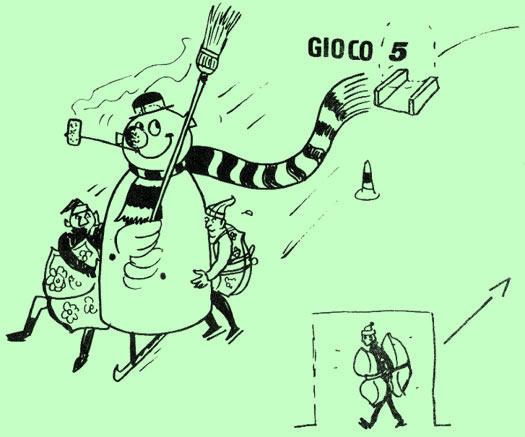 |
| Image ©
RAI, 1973 |
| |
This was a very straightforward game and ended with Great Britain and Italy
collecting 10 stockings each whilst Netherlands collected 6 stockings and
Belgium had collected 4 stockings.
|
Running Scores and Positions:
1st Cortina d'Ampezzo (I) (4pts awarded / 17pts total)
=2nd Aviemore (GB) (4pts / 13pts) ▲
=2nd The Dutch Sports Stars (NL) (2pts / 13pts)
4th Pepinster (B) (1pt / 9pts) |
|
Comments:
As can be seen in the official programme diagram above,
this was originally intended to be the sixth game. However, by the time of
recording the order of play had been changed and this game had been
swapped with the following game. The reason for this remains unclear.
|
Game 6 - Giant Mono-Skiing
Snowmen
The
sixth game - ‘Giant Mono-Skiing Snowmen’ - was introduced by RTB commentator
Michel Lemaire and played over two heats of two minutes duration. It featured
two male competitors from each team and a giant 4m (13ft 1½in) high snowman
‘standing’ on a mono-ski. The snowman comprised two parts, lower torso and
head with upper body, the latter being held together by a giant scarf wrapped
around the neck and crossed over at the front. On the whistle, the competitors
had to ski with the snowman up the 15m (49ft 2½in) course, circumnavigate a
small Christmas tree and then return to the start. This then had to be
repeated on two more occasions and after all three runs had been completed the
time would be taken. The team completing the game in the faster time would be
declared the winners.
| |
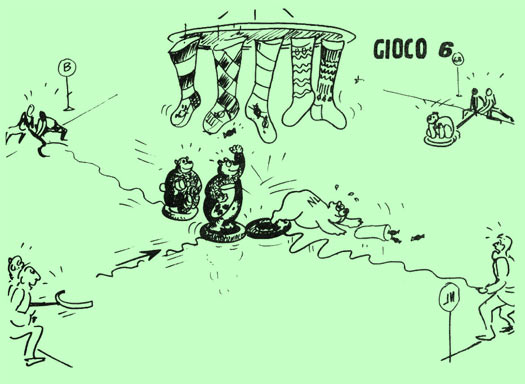 |
| Image ©
RAI, 1973 |
| |
The first heat of this straightforward and uneventful game saw the
participation of Belgium and Great Britain. Despite a fast start by Great
Britain, Belgium had closed the deficit by the first return journey with both
teams starting their second runs after 26 seconds of elapsed time. After the
second return journey, Great Britain had a slight lead of just two seconds at
the start of the third run. However, Belgium had closed the gap by the end of
the final outward journey and eventually overtook their rivals. Belgium
finished the game in 1 minute 20 seconds marginally ahead of Great Britain who
crossed the line in 1 minute 21 seconds.
The second heat featured Italy and Netherlands and from the outset Italy took
the lead. After completing their first return journey after 18 seconds of
elapsed time and two seconds ahead of their rivals, they did not falter and
completed the second run after 40 seconds followed by Netherlands in 43
seconds. Despite all their efforts, the Dutch competitors could not emulate
their rivals and the game ended with Italy crossing the finish line in 1
minute 3 seconds followed by Netherlands in 1 minute 5 seconds.
|
Running Scores and Positions:
1st Cortina d'Ampezzo (I) (4pts awarded / 21pts total)
2nd The Dutch Sports Stars (NL) (3pts / 16pts)
3rd Aviemore (GB) (1pt / 14pts) ▼
4th Pepinster (B) (2pts / 11pts) |
|
Comments:
As can be seen in the official programme diagram above,
this was originally intended to be the fifth game. However, by the time of
recording the order of play had been changed and this game had been
swapped with the previous game. The reason for this remains unclear. |
Game 7 - The Ostrich Eggs
The
seventh and penultimate game - ‘The Ostrich Eggs’ - was introduced by NCRV
commentator Dick Passchier and played individually over 1 minute 30 seconds
duration. It featured a female competitor from each team equipped with a small
baton and a large ostrich egg (in reality a large white balloon) standing at
one end of the 15m course and an opposition male team-member dressed as an
ostrich at the other. On the whistle, the competitor had to skate down the
course keeping the balloon aloft using the baton whilst the opposition had to
prevent from doing so by bursting the balloon with a pin attached to the head
of his ostrich costume or by forcing her to drop the balloon and permit it to
fall onto the ice. If the balloon touched the ice, the competitor had to
return to the start and repeat the game using a medium-sized baton. This would
be increased to a long baton (something that would impair the competitors’
control of the balloon) if a third run had to be made. However, if the
opposition ostrich fouled the competitor, he would be penalised by having to
reposition himself 10m (32ft 9¾in) metres back whilst the competitor could
recommence the game from the point of contact. This penalty would come to
assist one of the competitors somewhat in the third of the four heats. The
team completing the game in the faster time would be declared the winners.
| |
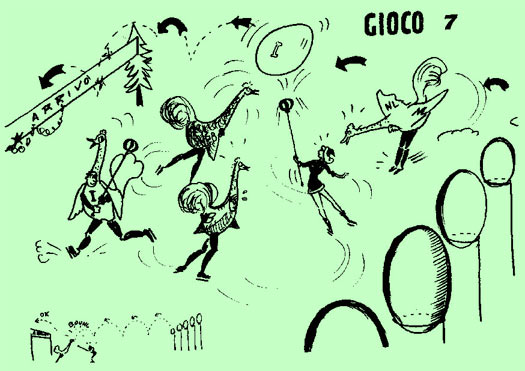 |
| Image ©
RAI, 1973 |
| |
The first heat saw the participation of Netherlands with Belgium in opposition
and, despite being fouled by the ostrich, they completed the task in 42
seconds.
The second heat featured Great Britain with Italy in opposition, and after
just seven seconds of elapsed time their first balloon had been burst by the
ostrich. Her second attempt did not fare much better with the balloon dropping
to the ice. The third and final attempt ended in the same vein as the first,
with the opposition bursting the balloon after 40 seconds of play and she was
declared out of time and given 0:00.
The third and penultimate heat was a reverse of the second with Italy
participating against Great Britain. On the first run, the competitor was very
canny by sending the balloon forward and high into the air which appeared to
discompose the opposition somewhat and also gave her time to position herself
for its descent. However, Italy were deemed to have been fouled just 2m (6ft
6¾in) from the finish line, and with the opposition penalised and having to
start 10m back, it was now a foregone conclusion that they would finish the
game within the permitted time. With the game restarted, it took just two
seconds for Italy to complete the game in 51 seconds.
The fourth and final heat was a reverse of the first with Belgium
participating against Netherlands. Unfortunately their competitor had hardly
got started before she permitted the balloon to fall onto the ice after just
two seconds of elapsed time. After this, she made heavy weather of the game
and permitted the other two balloons to suffer the same fate. As was the case
in the second heat, Belgium were declared as failing to complete the game and
were declared out-of-time.
|
Running Scores and Positions:
1st Cortina d'Ampezzo (I) (3pts awarded / 24pts total)
2nd The Dutch Sports Stars (NL) (4pts / 20pts)
3rd Aviemore (GB) (1pt / 15pts)
4th Pepinster (B) (1pt / 12pts) |
|
Comments:
With the points added to the scoreboard, Italy had already
accumulated sufficient points to secure overall victory. |
Game 8 - Caramels on the
Tree
The
eighth and final game - ‘Caramels on the Tree’ - was introduced by BBC
commentator Stuart Hall and played in unison over three minutes duration. It
featured two competitors (one male and one female) from each team and the
large Christmas tree utilised in the first game. However, on this occasion,
the tree had a length of rope attached to its base which was wrapped in tinsel
and had large Christmas ball decorations attached. On the whistle, the female
had to skate down the 5m (16ft 5in) course with a large wrapped caramel sweet
and then had to hang it from a hook attached to the bottom of the tree’s
branches. Contemporaneously, the male competitor had to make a
circumnavigation of the tree whilst holding onto the festive rope. Once this
was completed, the female then had to repeat the game throughout until all 15
caramels had been attached to the tree. The team hanging all the caramels from
the tree in the faster time would be the winners.
| |
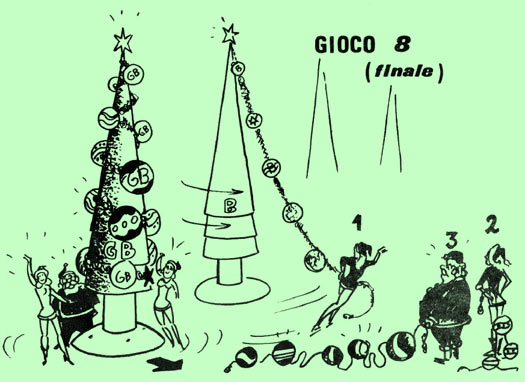 |
| Image ©
RAI, 1973 |
| |
This
was a very straightforward and quickly executed game which saw Italy finishing
in 1st place in 1 minute 23 seconds followed by Netherlands in 2nd place,
Belgium in 3rd place and Great Britain in 4th place.
|
Final Scores and Positions:
1st Cortina d'Ampezzo (I) (4pts awarded / 28pts total)
2nd The Dutch Sports Stars (NL) (3pts / 23pts)
3rd Aviemore (GB) (1pt / 16pts)
4th Pepinster (B) (2pts / 14pts) |
|
|
Presenters, Officials and Production Team |
|
The BBC chose not to send any officials to this event despite it being the
norm to do so. To ensure parity, the broadcaster requested that Switzerland
provide a referee on their behalf. |
|
Returning
Teams and Competitors |
|
Ad van Ommen, team captain for The Dutch Sports Stars, had
previously taken the same role with the highly successful team of Alphen aan
den Rijn, when they participated in Zeskamp during its 1969-1970 and 1970-71
seasons and the 1971 series of Jeux
Sans Frontières. He would again fulfil the same role for the Dutch team
in the 1974 Christmas Jeux Sans Frontières from Aviemore, Scotland. |
|
Made
in Colour • This programme exists in the BBC Archives |
|
|
|
JSFnetGB Series Guide pages researched by
Neil Storer and
Alan Hayes
with Ischa Bijl, Julien Dessy, Sébastien Dias, David Hamilton, Denis Kirsanov, Paul Leaver, Philippe Minet,
Christos Moustakas, David Laich Ruiz, Marko Voštan and JSFnet Websites |
|
|